Just mere hours before the election results from each separate state start pouring in, the stock market is at an impasse. Yesterday, tech stocks were able to recuperate slightly following a massive plunge last week, which is a sign of resistance from the market bulls. Nevertheless, the continuation of the bullish rally is still very much in question.
Depending on who wins tonight, the Nasdaq is likely to react in slightly different ways. If its Biden, the index could continue fluctuating in a narrow range, possibly extending the bearish correction in the near future. That is so because of his tax plans for the wealthy, and the general perception of how such bigger taxes could impede the stock market's performance.
Such downbeat reactions to a Biden presidency are highly unlikely to persist for too long, as he has been leading steadily in the polls since April. This means that the market has had enough time to price the longer-term implications of a democratic administration at the White House. Moreover, the accommodative monetary policy stance of the FED coupled with the robust economic performance that has been observed recently – manufacturing and durable goods orders - should continue to support the stock rally.
If, however, Trump manages to snatch a somewhat surprising re-election tonight, the Nasdaq could jump, similarly to what happened in the wake of the 2016 republicans' victory. That is so because Trump pledged to keep the American economy open, despite the surging coronavirus cases in the states.
As regards Biden's agenda for tackling the pandemic, he seems more likely to reintroduce partial lockdowns in areas with confirmed infection spikes. Even if he does so, the technological sector has already demonstrated substantial resilience to the adverse fallout from such economic closedowns during the first wave, so there is no logical reason to expect a Biden's presidency to bring about an end to Nasdaq's rally.
Overall, a fundamental examination of the Nasdaq reveals that the index is most probably going to continue advancing further north in the longer-term. However, depending on who comes on top tonight, the tribulations for the index could be extended in the near future before bulls regain full control.
1. Long-Term Outlook:
As can be seen on the daily chart below, the price action of the Nasdaq could have already established a Double Top pattern just above the psychologically significant resistance level at 12000.00. While such patterns typically entail the development of bearish reversals, this does not necessarily have to be the case at present.
The index is currently consolidating just above the 100-day MA (in blue), which represents a crucially important floating support, and a potential turning point for the direction of the price action. Moreover, the moving average is presently converging towards the 23.6 per cent Fibonacci retracement level at 11103.68, which, too, bears considerable psychological significance.
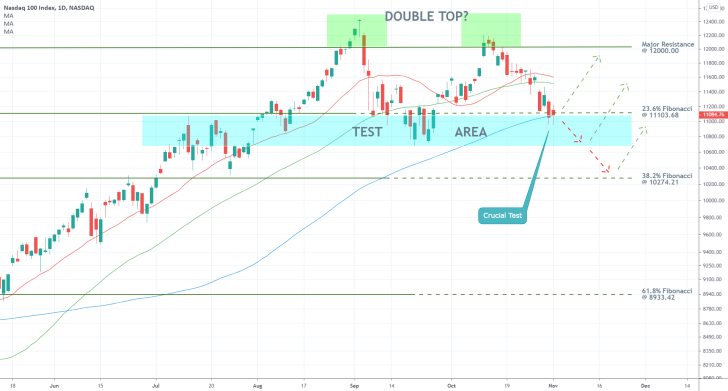
Given that the 20-day MA (in red) remains threading above the 50-day MA (in green), a termination of the current bearish correction seems highly probable to occur now, at the spot price. If, however, the price action fails the current test level and breaks down below the 23.6 per cent Fibonacci, it could consolidate within the boundaries of the Test Area next.
The lowest that the price action could tumble to before the bulls regain control is the 38.2 per cent Fibonacci retracement at 10274.21. Correspondingly, the next bullish upswing is bound to test the psychological barrier at 12000.00 one more time.
2. Short-Term Outlook:
The technical outlook on a chart with a smaller timeframe is slightly different. The price action is currently probing the upper boundary of the Test Area, which is encapsulated by the 23.6 per cent Fibonacci, as can be seen on the 4H chart below. Its lower limit can be found at around the 10750.00 price level.
The latter is determined from the lowest point of the ABC correction that ensued following the Nasdaq's all-time record at around 12400.00 – the dip at point C. After the ABC correction was completed, the price action went on to establish a bullish 1-5 impulse wave pattern, as postulated by the Elliott Wave Theory. It peaked at point 5 just above the major resistance at 12000.00. From it, a descending trend line can be drawn, which could then be used to test subsequent bullish upswings.
Notice that the area around the peak at point B and the height of the impulse leg 2-3, serves the role of a major Bullish Test Area. Hence, the strength of any future upswings is likely to be tested within set area, and the behaviour of the price action within this area is going to demonstrate traders the exact extent of the underlying bullish commitment in the market.
Conversely, a breakdown below 10750.00 would mean that the price action is ready to enter within the Bearish Test Area, which correspondingly would test the underlying bearish commitment in the market.
At present, the prevalence of selling pressure could be inferred from the MACD indicator, which is underpinning strong bearish momentum, and also from the Parabolic SAR indicator.
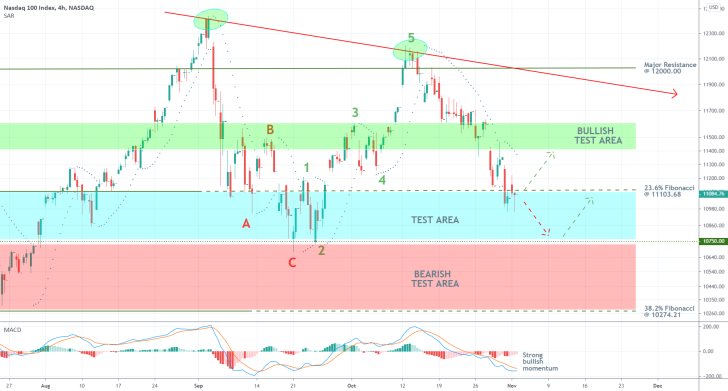
3. Concluding Remarks:
In determining how to position themselves, traders need to observe two key developments – the outcome of the US Election, and the behaviour of the price action around the 100-day MA. Overall, the underlying market setup seems favourable for the implementation of trend-continuation strategies around the aforementioned moving average; however, the bulls should keep in mind that the anticipated surge of uncertainty stemming from the Presidential Race could cause adverse bearish fluctuations in the near future.
Make-It-Or-Break-It Scenario for the Nasdaq
The price action of the Nasdaq is currently consolidating around a crucial resistance level, and its behaviour around this psychological barrier is going to demonstrate how the underlying sentiment is presently changing. As it is about to be seen, the market appears to be forming a trend-reversal pattern at present, which would entail the subsequent emergence of a new downtrend; however, a decisive breakout above the above-mentioned resistance would manifest a likely continuation of the prevailing uptrend.
That is why the underlying fundamentals are probably going to play a significant role for the near future of the index, especially in light of the seemingly uneventful week ahead. On the one hand, the continued depreciation of headline unemployment in the US is a good thing for the strengthening of the technological sector. On the other hand, further monetary policy interventions by the FED could take place in December at the earliest, which means that the index remains vulnerable to sudden ripples until then.
While the encouraging vaccine news by Pfizer and BioNTech have excited the global stock market, the resulting investors' enthusiasm is poised to have a diminishing effect on the Nasdaq as more and more people realise that much of the coronavirus-related problems for the global economy persist.
At any rate, even if the Nasdaq does continue to rise by the end of the year, given the weight of the accumulated selling pressure, the index looks poised to form at least one more sizable correction in the following weeks.
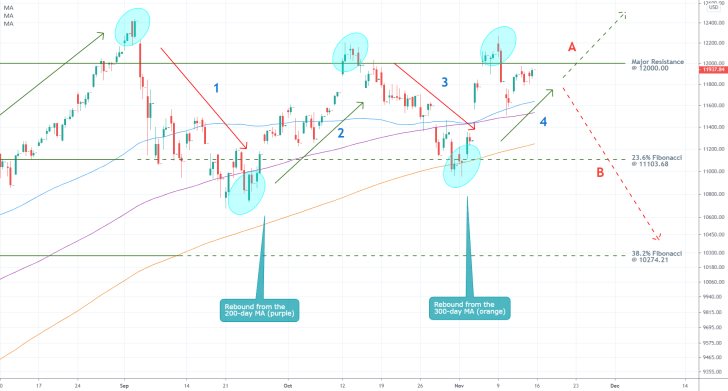
As can be seen on the 4H chart above, the price action has been consolidating in an increasingly narrower 'bottleneck' since late-September. This can be both an indication for a future trend-reversal or an interim stage in the development of the broader uptrend, depending on how the price action behaves around the major resistance level at 12000.0 next.
The price of the Nasdaq has already failed to break out above the resistance on three separate occasions, and it will take only a decisive breakout (point A) to ensure the continuation of the bullish rally. In contrast, the increasingly more concentrated price action – the development of narrower swing lows and swing highs – is taking the form of a 1-2-3-4 pattern, which could pan out to be a trend reversal signal.
A breakdown below the 23.6 per cent Fibonacci retracement level at 11103.68 would complete the pattern (at point B) and would allow the price action to extend its dropdown towards the next major support – the 38.2 per cent Fibonacci at 10274.21.
While it is clear what bulls need to look for in order to use trend-continuation strategies, bears need to be more cautious in utilising contrarian trading strategies. On the one hand, the testing of the 200-day MA (in purple) followed by a test of the 300-day MA (in orange), elucidates the rising bearish pressure. On the other hand, the execution of selling orders would be warranted only on the condition that the price action does rebound from the 12000.0 resistance level.
At any rate, both bulls and bears should monitor the behaviour of the price action around this resistance, as the bottleneck setup unfolds, before they place any orders.
The Nasdaq Advances in the Hanging Man's Shadow
The Nasdaq has expectedly broken out above a major resistance level, as per the projections of the original analysis, and is currently headed towards its all-time peak. But can the technological index establish a new record amidst the current vaccine optimism?
A mixture of positive developments is currently driving the US stock market. Over the next couple of days, the 120th OPEC conference is expected to underscore the rebound in global demand for crude oil, which represents the most significant determinant of the rally. Moreover, the stymied demand for safe-havens and other low-risk securities is having a positive impact on the global demand for stocks.
Finally, the reeling greenback in addition to the post-Black Friday return to normalisation should also be considered as contributing factors to the advancing stock market rally.
All underlying fundamentals seem to support the expectations for continued price appreciation, but how far can Nasdaq's price go before another bearish correction forms?
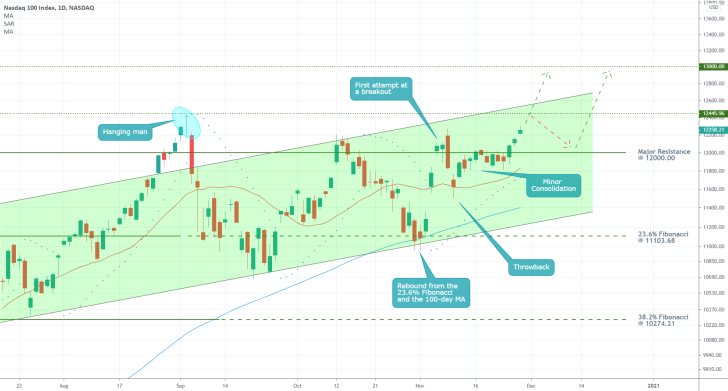
As can be seen on the daily chart above, the price action is advancing within the boundaries of an ascending channel. The first major bullish confirmation was the rebound from the 100-day MA (in blue) and the 23.6 per cent Fibonacci retracement level at 11103.68, which was pointed out in the last follow-up.
Afterwards, the price action attempted a false breakout above the psychologically significant resistance at 12000.00, before retracing to the 50-day MA (in red). Note that the two moving averages serve the roles of floating supports. The last follow-up successfully recognised the resulting consolidation range (minor) as an intermediate stage in the development of the broader uptrend. The temporary consolidation of the price action just below 12000.00 was a prelude to the eventual decisive breakout.
Now that the price action is once again enjoying strong bullish sentiment, being affected positively by the aforementioned fundamental factors, it is quite likely to test the all-time high at 12445.00 next. This level is currently converging with the upper boundary of the channel, which makes it an even more pronounced resistance and a likely turning point.
The 12445.00 level was established as a prominent resistance upon the creation of the 'Hanging Man' candlestick. Due to its well-known role as a bearish-entailing candle, this Hanging Man's peak would very likely represent a major obstacle for the currently advancing upswing.
That is why our first baseline scenario – the more pessimistic one – weighs in on the possibility for the development of a minor bearish correction from 12445.00 towards the psychologically significant 12000.00 level (now serving the role of support). This is, in a sense, a worst-case-scenario for the bulls, who expect to see the price action continuing with its advance in the long-term.
If, however, the Nasdaq manages to break out above its previous record, then the next most likely target would be the psychologically significant resistance at 13000.00. Our second scenario anticipates such a development, given the strong bullish fundamentals and the current reading of the Parabolic SAR indicator.
Where Will Nasdaq's Retracement Bottom Out?
The Nasdaq rose by nearly 1000 points since the US Presidential election in November, and the index is currently trading just below its all-time high at 12635.00. The underlying price action started developing a minor bearish correction last week, which can be used by market bulls to gain favourable entry. By implementing trend-continuation trading strategies, they can join the existing uptrend at the next dip. That is why the question of where the current retracement will bottom out is so important.
Traders should keep in mind that the market liquidity is likely to drop drastically over Christmas as the general trading activity wanes. However, also due to the impact of market seasonality, the underlying liquidity levels are very likely to surge back in early-January as the activity picks up once again. Highly optimistic traders and investors tend to begin each new year on a high note, which typically drives the stock market up north.
That is why trading on the Nasdaq over the next couple of weeks should be done with extra caution as the anticipated drop in the underlying liquidity levels could cause erratic price fluctuations. Yet, the perceived fundamental picture in January seems very suitable for the adoption of such trend-continuation strategies.
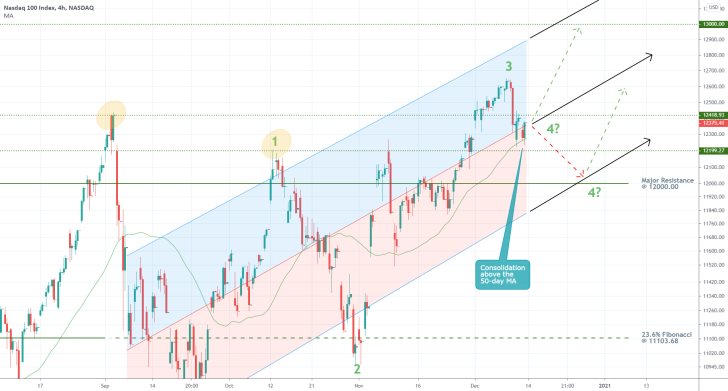
As regards the current technical outlook, the price action seems to be concentrating around several crucially important supports in the short run. As can be seen on the 4H chart above, the recent correction drove the price action to the middle line of the regression channel. The latter coincides with the 50-day MA (in green), which could also serve as a potential turning point.
Moreover, the current price action is also concentrated between the 12418.93 resistance and the 12199.27 support. These two represent the peaks of the previous swing highs, which further substantiates the expectations for an immediate bullish rebound. Such a rebound would have the psychologically significant resistance level at 13000.00 as its first major target. Furthermore, the latter would converge with the upper boundary of the regression channel, which would make it an even more prominent level.
The current uptrend takes the form of a 1-5 impulse wave pattern, as postulated by the Elliott Wave Theory. As such, the bearish correction can be perceived as the 3-4 retracement leg of the broader pattern. It follows that, if the price action manages to break down below the 50-day MA and the middle line of the channel, then the 3-4 retracement can be extended even lower towards the major resistance (currently support) at 12000.00. Notice that the lower band of the regression channel would coincide with this support level in the near future, which would make it an even more significant turning point.
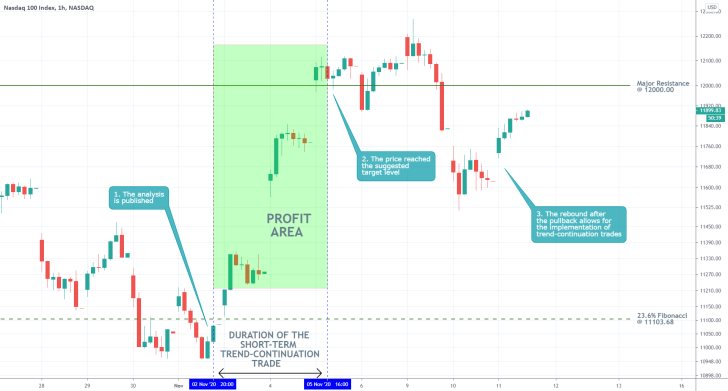
- An almost perfect execution! This trade shows the importance of good timing in trading – namely, the need to watch for good opportunities to join an existing trend when all underlying indicators seem to suggest a likely continuation of that trend.
- The price action of the Nasdaq went north after Joe Biden's win in the presidential elections coupled with the recent vaccine news. Given the conclusion of the latest pullback, the price action is likely to resume advancing higher.
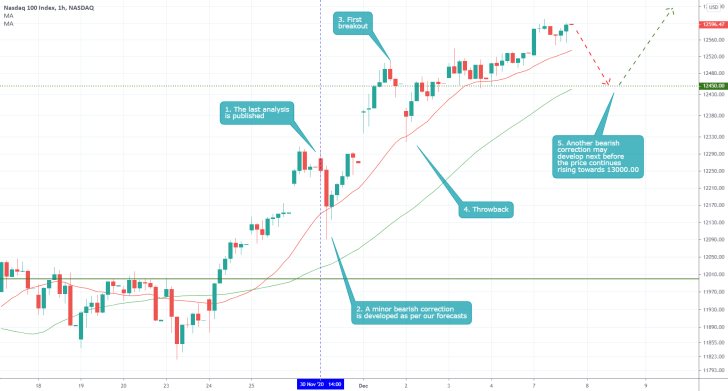
- The projections of the last follow-up were almost perfect in that the price action did correct itself before continuing to appreciate further north. The correction itself, however, came short of the initial projections – it bottomed out above the 12000.00 support.
- Now that the price action has broken out above 12450.00, the road is cleared for it to continue rallying towards the psychological resistance at 13000.00. Before this happens, however, the price action can establish another correction to 12450.00.
- The above example demonstrates the importance of patience in trading, particularly when trading with indices and stocks.
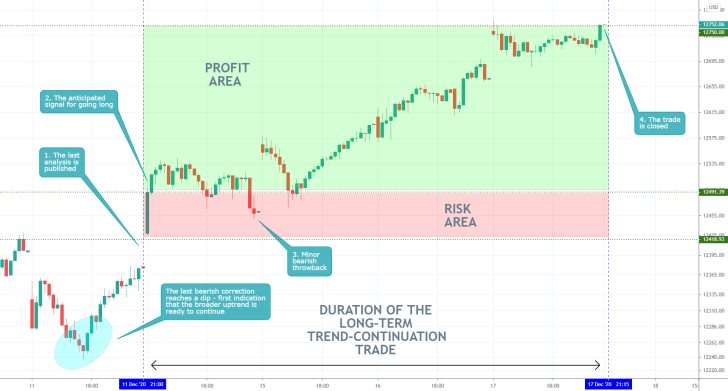
- Almost perfect execution of the last follow-up! It was quite precise in anticipating the end of the last bearish correction, which allowed for the implementation of trend-continuation trading strategies. Goes to show why patience is a virtue in trading!
Disclaimer: Your capital is at risk! Trading and investing on the financial markets carries a significant risk of loss. Each material, shown on this website, is provided for educational purposes only. A perfect, 100% accurate method of analysis does not exist. If you make a decision to trade or invest, based on the information from this website, you will be doing it at your own risk. Under no circumstances is Trendsharks responsible for any capital losses or damages you might suffer, while using the company’s products and services. For more information read our Terms & Conditions and Risk Disclaimer.





















